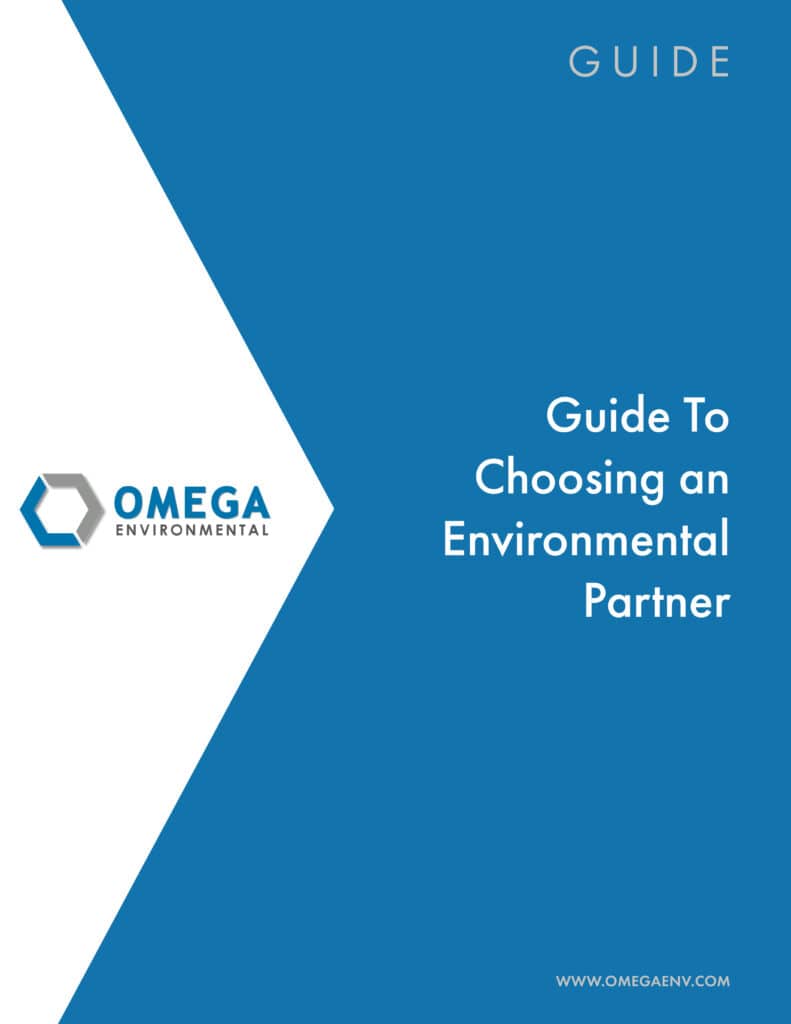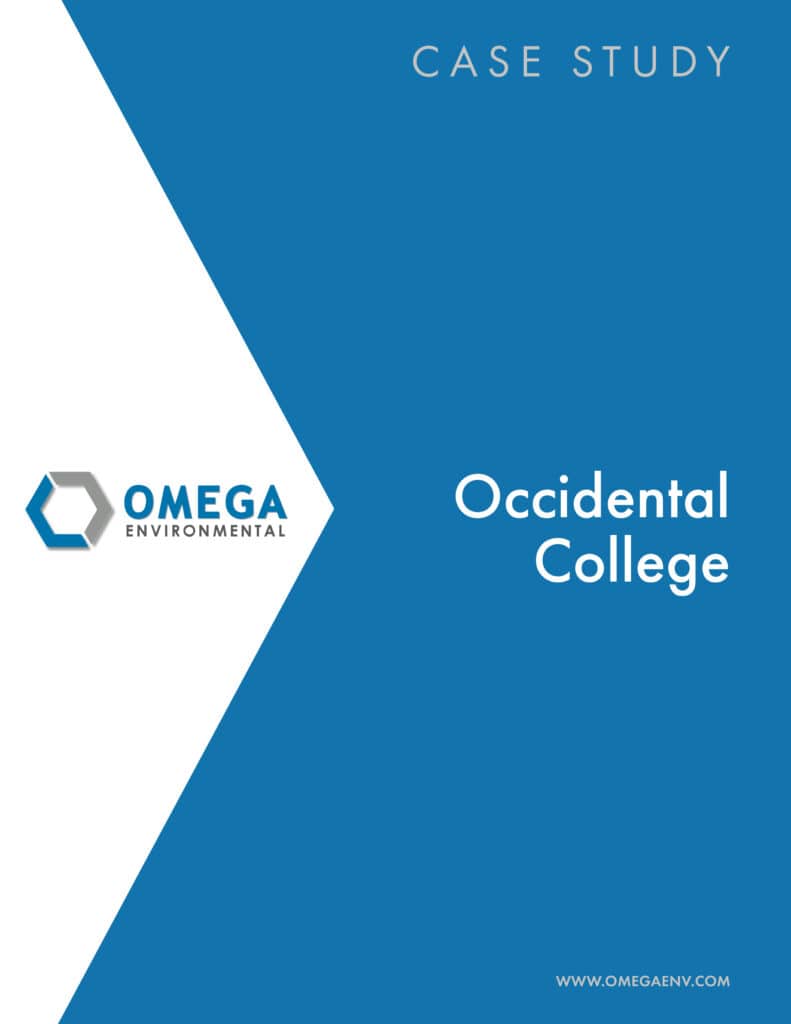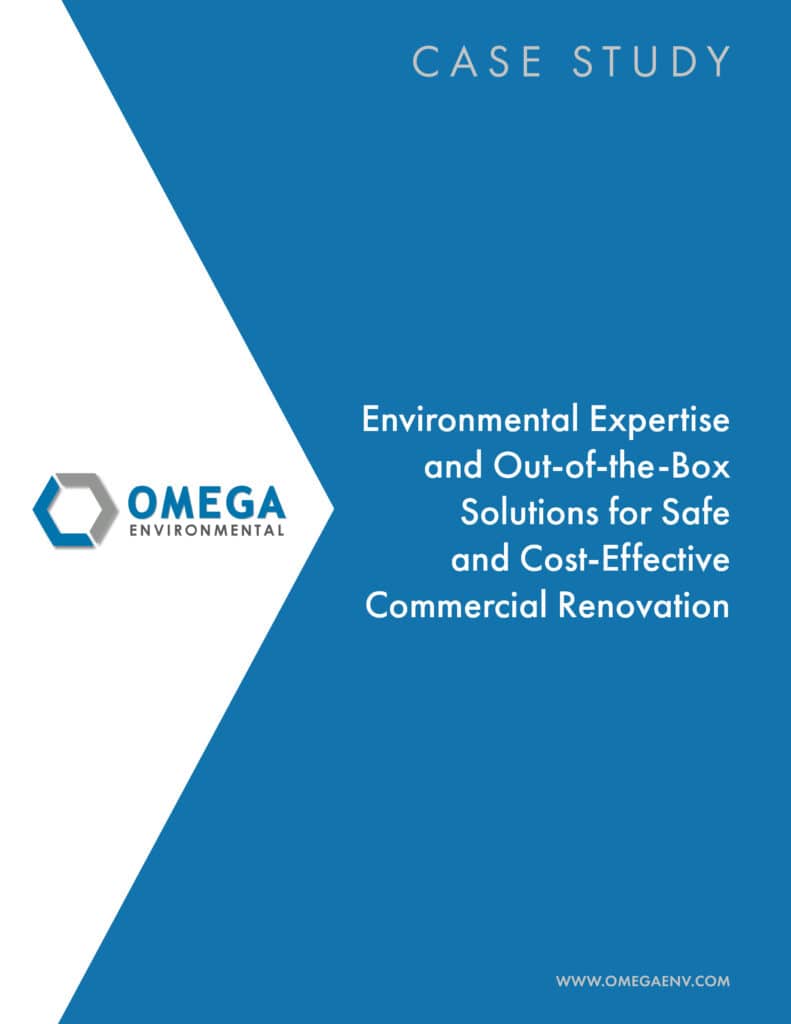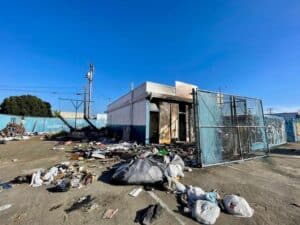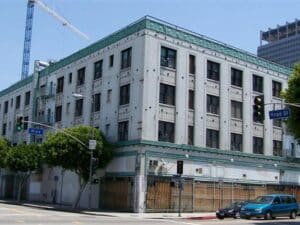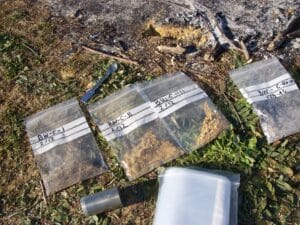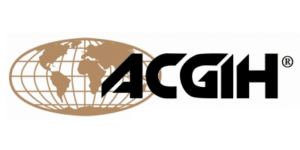Recognizing the 10 Warning Signs of Mold Toxicity in Your Building
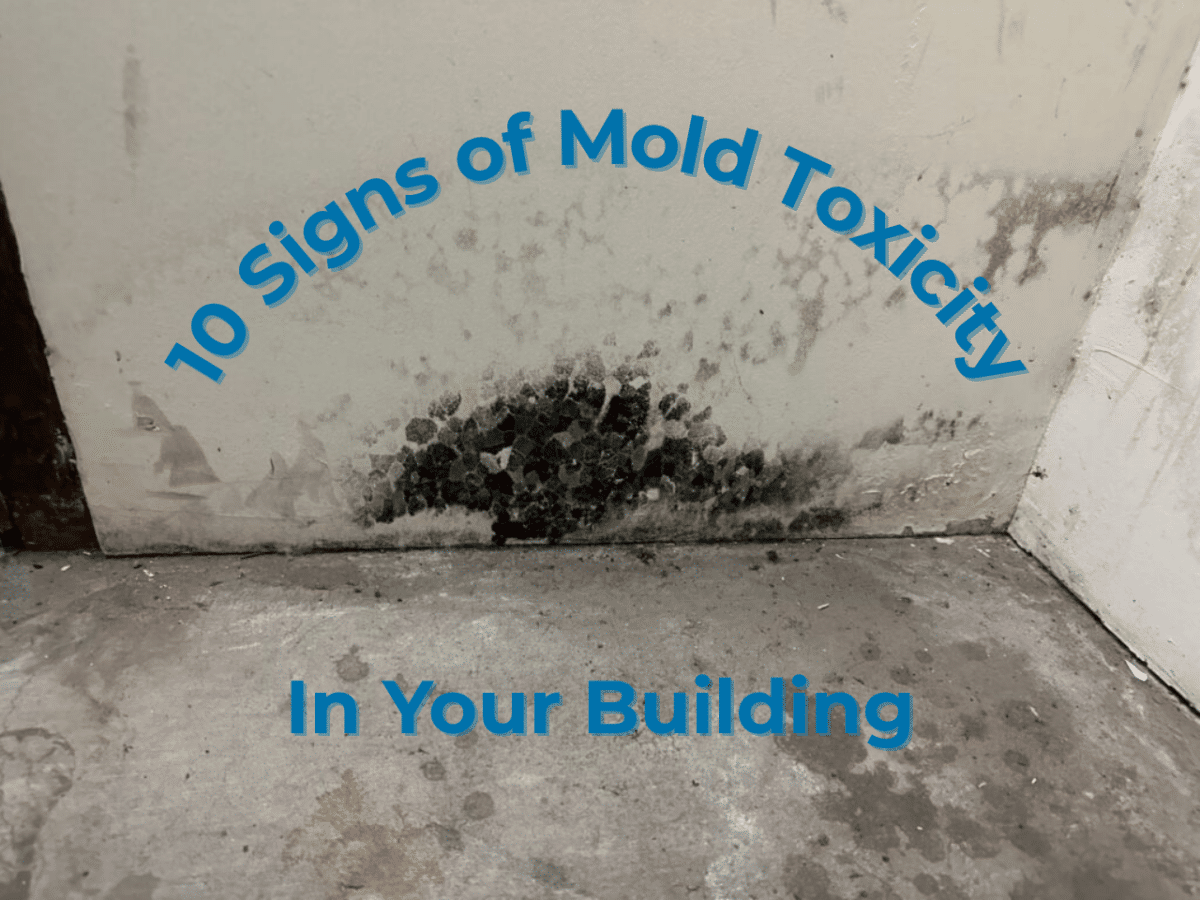
Recognizing the 10 Warning Signs of Mold Toxicity in Your Building
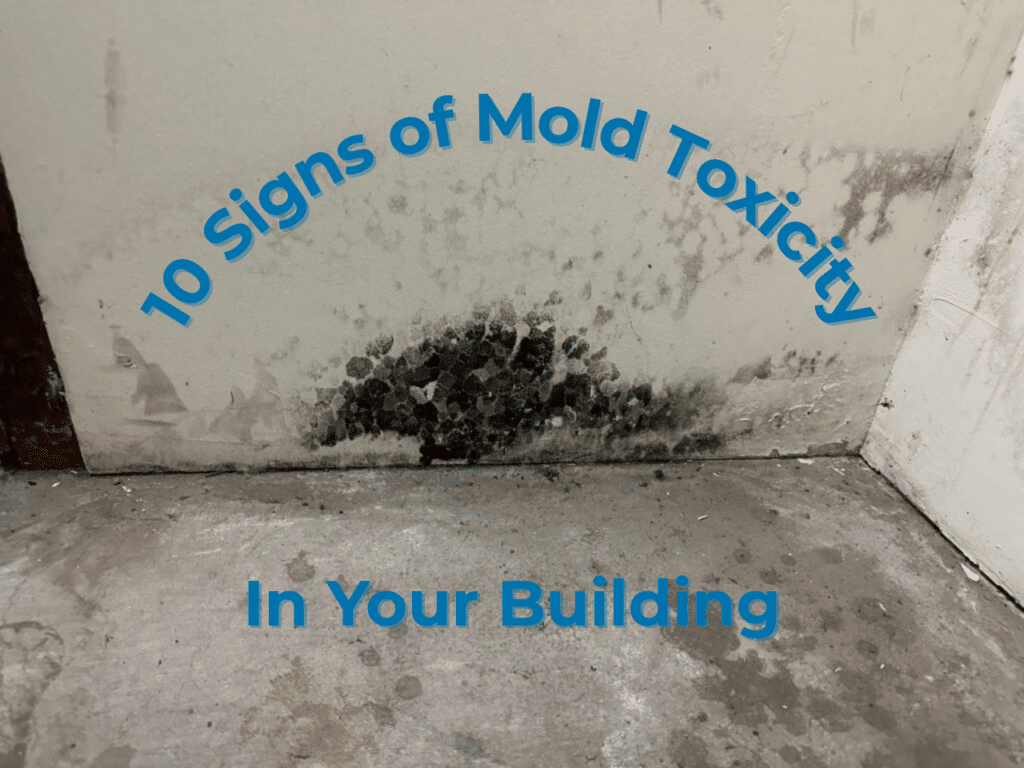
Mold toxicity can silently compromise your facility’s indoor air quality and threaten the health of everyone inside. When moisture infiltrates commercial buildings through leaks, floods, or inadequate ventilation, it creates ideal conditions for toxic mold species to flourish—releasing dangerous mycotoxins that can have serious health consequences.
Quick Reference: 10 Warning Signs of Mold Toxicity
- Persistent coughing and wheezing
- Chronic sinus congestion
- Worsening asthma symptoms
- Brain fog and memory issues
- Difficulty concentrating
- Frequent headaches and migraines
- Chronic fatigue
- Unexplained muscle and joint pain
- Skin rashes or irritation
- Digestive issues and nausea
Unlike simple mold allergies, mold toxicity occurs when occupants are exposed to mycotoxins—toxic compounds from molds like Stachybotrys chartarum (black mold), Aspergillus, and Penicillium. These toxins can cause serious health problems that affect productivity, increase absenteeism, and create significant liability risks for building owners.
Research shows a significant percentage of commercial buildings face moisture and mold challenges. According to the EPA’s guidance on mold remediation, the consequences extend beyond health concerns, with facility managers reporting decreased productivity, increased employee complaints, and potential legal exposure when mold toxicity goes unaddressed. Mold can spread rapidly within 48 to 72 hours if moisture issues aren’t resolved, making early detection critical.
Understanding Mold Toxicity in a Commercial Environment
As a Property or Facility Manager, you know mold is a problem. But there’s a critical difference between simple mold exposure and the more serious threat of mold toxicity. Understanding this distinction is key to protecting your occupants.
Mold exposure to common spores may trigger mild allergic reactions, like sneezing or watery eyes.
Mold toxicity, however, is a poisoning that occurs when certain molds produce toxic compounds called mycotoxins. These toxins can be inhaled, absorbed, or ingested, causing widespread health problems that go far beyond a runny nose. The most common mycotoxin producers in commercial buildings are Stachybotrys chartarum (“black mold”), Aspergillus, and Penicillium. They thrive on moisture-rich materials like drywall and ceiling tiles, releasing toxins into the air.
Prolonged exposure can lead to Chronic Inflammatory Response Syndrome (CIRS), a persistent inflammatory state affecting multiple organs. As confirmed by scientific research on mold health effects from the CDC, mycotoxin exposure can cause severe, long-lasting health problems.
Certain building occupants face higher risks. Employees with asthma and immunocompromised tenants are particularly vulnerable. Some individuals also have genetic variations that hinder their ability to eliminate mycotoxins, making them susceptible to the 10 warning signs of mold toxicity even at low exposure levels.
Recognizing that mold toxicity causes serious health problems, not just temporary discomfort, allows you to take proactive steps to maintain a healthy facility. Our guide on Breathe Easy with Indoor Air Quality Management offers more strategies for this.
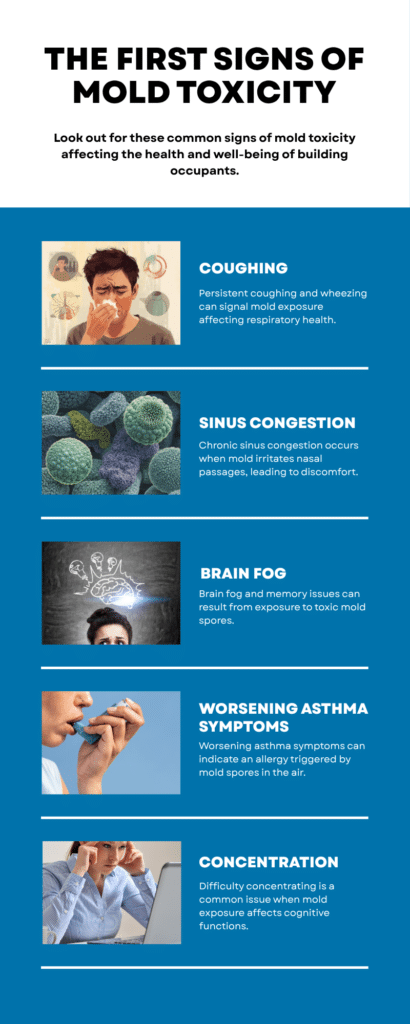
The 10 Warning Signs of Mold Toxicity Affecting Your Occupants
As a Property or Facility manager, you might notice troubling patterns: employees calling in sick more often, complaints about the building environment, or unexplained drops in productivity. These could be early indicators that mold toxicity is affecting your commercial property. When occupants begin experiencing health symptoms, the impact quickly spreads—from increased tenant complaints to decreased performance as staff struggle with both cognitive and physical effects.
Recognizing these signs early can prevent a minor problem from escalating into expensive remediation and serious liability issues. The 10 warning signs of mold toxicity below are the most frequent symptoms found in commercial buildings with mycotoxin exposure.
1-3: Respiratory and Allergic Reactions
The respiratory system typically reacts first, serving as an early warning system for compromised air quality.
- Persistent coughing and wheezing ranks among the most common complaints. Unlike seasonal allergies, this cough persists for weeks or months and typically intensifies during work hours.
- Chronic sinus congestion plagues many exposed individuals, who report constant stuffiness, recurring sinus infections, and postnasal drip that disrupts their workday.
- Worsening asthma symptoms can escalate a manageable condition into a workplace crisis. Employees may require rescue inhalers more frequently or suffer attacks while at work.
Case Study: Educational Facility HVAC Contamination
A school’s administrative wing experienced a surge in respiratory problems among staff. Persistent coughing and aggravated asthma symptoms became widespread, with a telling pattern—symptoms improved during breaks but returned once staff came back to work. Investigation revealed extensive mold growth in the HVAC system caused by a slow condensate drain leak. Following HVAC decontamination and moisture control repairs, respiratory complaints plummeted by 85% within six weeks.
This case underscores a critical question every facility manager should ask: Is mold growing in your building?
4-6: Neurological and Cognitive Impairment
Mycotoxins can breach the blood-brain barrier, triggering neurological symptoms that severely impact workplace performance.
- Brain fog and memory issues rank among the most debilitating effects. Employees describe mental cloudiness and short-term memory lapses that make even routine tasks feel insurmountable.
- Difficulty concentrating transforms productive workers into struggling team members. Simple tasks stretch into lengthy ordeals, creating frustration in fast-paced environments.
- Frequent headaches and migraines typically follow a telltale pattern—developing during work hours and subsiding after employees leave the building. These headaches are generally more intense and persistent than ordinary tension headaches.
Case Study: Corporate Office Productivity Crisis
A tech company’s marketing department saw productivity drop 40% in three months. Staff reported an inability to concentrate, persistent headaches, and “mental exhaustion.” An assessment revealed hidden mold behind water-damaged drywall. After proper remediation, productivity returned to normal, mirroring challenges described in our article about Protecting US Embassy Workers from the Threat of Mold.
7-10: Systemic and Unexplained Symptoms
This final category of symptoms may seem puzzling, but it often provides the strongest evidence of mycotoxin exposure.
- Chronic fatigue goes beyond ordinary tiredness—it’s a profound exhaustion that rest can’t cure. Mycotoxins disrupt mitochondrial function, undermining the body’s ability to produce cellular energy.
- Unexplained muscle and joint pain create widespread aches and stiffness that mimics flu symptoms without the accompanying fever.
- Skin rashes or irritation varies from mild itching and hives to severe dermatitis or an unsettling “crawling” sensation on the skin.
- Digestive issues and nausea round out the symptoms. Occupants may suffer from bloating, abdominal pain, or persistent queasiness, while some develop heightened sensitivity to light and sound.
The distinction lies in severity and scope. Mold allergies trigger standard immune responses like sneezing and runny noses. Mold toxicity causes systemic poisoning—neurological impairment, widespread inflammation, and multi-organ dysfunction. When several occupants report multiple symptoms from this list, professional assessment becomes essential.
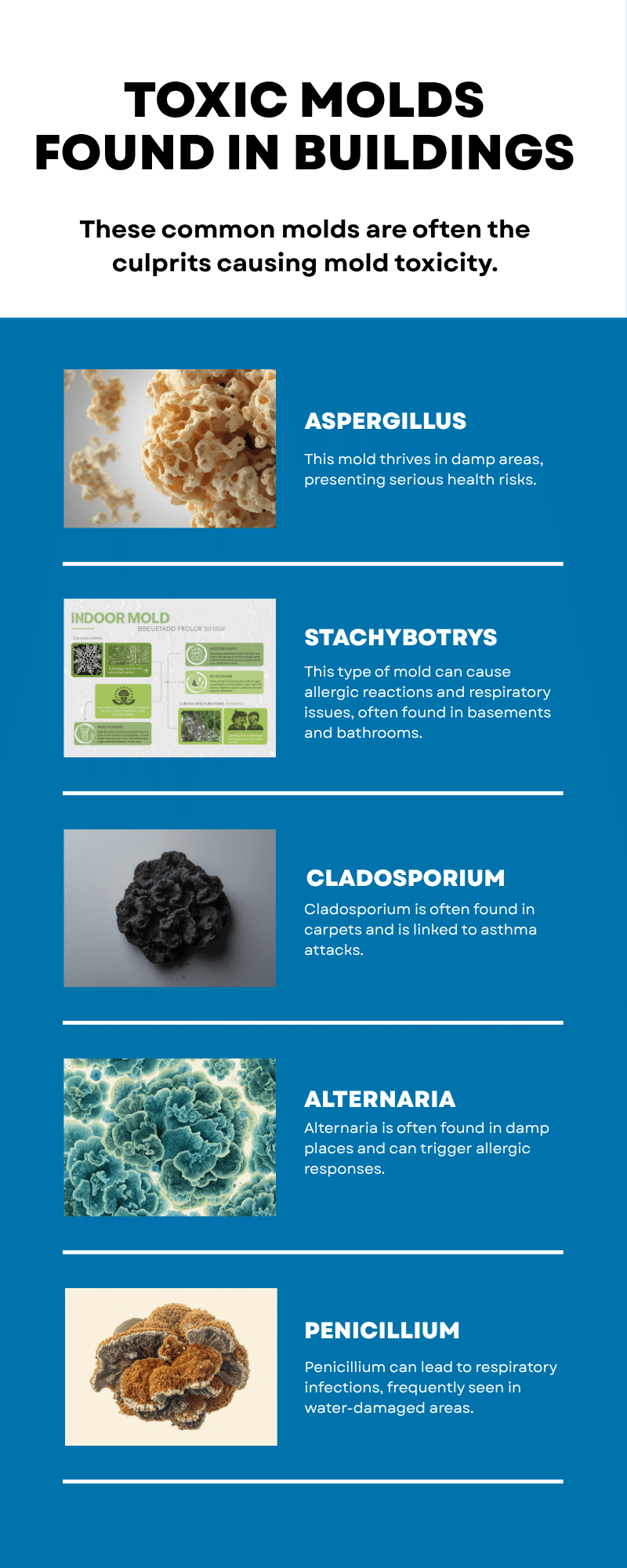
Identifying and Addressing Mold Sources in Your Facility
Recognizing the 10 warning signs of mold toxicity is only the beginning. The crucial next step is locating and eliminating the moisture sources that fuel mold growth in your facility.
A persistent musty odor often provides the first warning—caused by microbial volatile organic compounds (mVOCs) released by growing mold. Visual indicators include discoloration on walls or ceilings, water stains on ceiling tiles, peeling paint, and warped flooring.
Common Areas for Mold Problems in Buildings
Several areas consistently harbor mold problems:
- HVAC systems: Clogged condensate pans, damp ductwork, and neglected cooling coils can spread spores and mycotoxins throughout your entire building.
- Basements and utility areas: Poor ventilation combined with high humidity and concealed leaks creates perfect breeding conditions.
- Plumbing chases and mechanical rooms: Even minor drips can saturate drywall and insulation, fostering hidden mold colonies behind walls.
- Roof and Window leaks: Water often travels considerable distances from its entry point, causing mold growth on lower floors in seemingly dry areas.
- Exterior irrigation systems: Water directed at building walls, sill plate and windows causing water to travel into walls and underneath floors.
Swift action is essential once mold is detected. For comprehensive guidance on response protocols, see “What to Do If Mold Is Growing in Your Building.” The broader financial consequences of moisture problems are examined in “When Moisture in Your Building is Costing You.”
Prevention remains your most effective strategy. Success requires a systematic approach:
- Moisture control: This forms the foundation of mold prevention. Address all leaks immediately—whether from plumbing, roofing, windows, or HVAC systems.
- Humidity monitoring: Keep indoor humidity between 30% and 50% to create conditions where mold cannot thrive.
- Regular inspections: Schedule routine checks of high-risk areas including utility rooms, basements, and areas surrounding plumbing fixtures.
- Swift leak repair: Since mold can establish itself within 24-48 hours, today’s small leak becomes tomorrow’s major problem without immediate attention.
- Adequate ventilation: Ensure restrooms, food service areas, and mechanical rooms effectively exhaust humid air to the outdoors.
For new construction projects, implementing Moisture Monitoring from the outset prevents future problems. A comprehensive approach to Preventing and Managing Indoor Air Quality Issues weaves mold prevention into your broader building health strategy.
When to Call for Professional Assessment
While your team can manage minor issues, certain situations require professional expertise:
- Extensive visible growth (exceeding 10 square feet) demands professional containment to prevent spore dispersal during remediation.
- Ongoing occupant complaints that align with mold toxicity symptoms indicate hidden contamination requiring specialized investigation.
- Major water events or flooding typically necessitate professional evaluation to locate concealed moisture in wall cavities and HVAC systems.
- Suspected HVAC contamination requires expert assessment, since contaminated systems can distribute mold spores building-wide.
- Liability protection through professional documentation demonstrates due diligence and proves essential when addressing health-related complaints.
Omega’s expertise in Microbial Indoor Air Quality Assessments for a Safe Return to Work demonstrates how professional evaluation delivers the critical data and actionable plans needed to resolve mold issues effectively.
Frequently Asked Questions about Mold in Commercial Buildings
What are the long-term consequences of unaddressed mold in a building?
Ignoring mold problems can devastate both your property and your organization. Here’s how:
- Structural deterioration: Mold feeds on organic materials like wood and drywall, progressively weakening structural integrity and requiring costly repairs.
- Property devaluation: Buildings with mold histories suffer significant market value losses, as potential buyers account for health risks and anticipated remediation expenses.
- Chronic health complications: Extended exposure can trigger lasting respiratory conditions and cognitive decline in occupants, generating ongoing workers’ compensation claims.
- Legal exposure: Delayed response can result in multimillion-dollar lawsuits from occupants who develop serious health conditions.
- Reputational harm: Mold problems become public knowledge quickly, making tenant attraction and retention increasingly difficult.
Our Microbiological Decontamination services can address these risks, though prevention proves far more economical.
How can I differentiate between symptoms of mold toxicity and general “sick building syndrome”?
This distinction directly impacts your response strategy and potential liability. Sick Building Syndrome (SBS) encompasses occupant health effects without identifiable specific causes:
- Symptom severity: SBS typically produces mild, general complaints like headaches or eye irritation. The 10 warning signs of mold toxicity manifest as more severe, specific symptoms including cognitive impairment and muscle pain.
- Neurological impact: Mold toxicity can trigger profound brain fog and memory loss that far exceeds the minor concentration difficulties associated with SBS.
- Duration: SBS symptoms generally resolve quickly after leaving the building, while mold toxicity effects can persist for days or weeks.
Professional indoor air quality (IAQ) testing provides definitive answers by identifying specific mold species and measuring mycotoxin concentrations.
Does the type of mold determine the risk level for my building?
This represents a common misconception. While certain molds pose greater dangers, all mold growth demands immediate action:
- Universal liability: Any proliferation of mold species can trigger allergic reactions and signal moisture control failure, creating legal vulnerability.
- Enhanced risks from toxin-producing species: Molds such as Stachybotrys and Aspergillus release mycotoxins that cause the severe systemic effects of mold toxicity.
- Consistent remediation approach: Regardless of species, the solution remains constant—eliminate moisture sources, remove contaminated materials, and restore healthy indoor conditions.
The critical point for facility managers: any mold growth indicates building system failure requiring immediate intervention.
Protecting Your Building and Its Occupants from Mold
Mold in your building represents far more than an aesthetic concern hidden in forgotten corners. It’s a silent threat that can undermine your most valuable assets—from your property’s structural integrity to the health and productivity of everyone who enters your facility.
Recognizing the 10 warning signs of mold toxicity—from brain fog to chronic fatigue—should trigger immediate action. These symptoms indicate real health crises unfolding within your building, creating risks that span from decreased productivity to substantial legal liability.
Proactive management serves as your most effective defense. This requires systematic inspections of HVAC systems, basements, and plumbing areas to eliminate moisture before mold can establish itself. Professional testing proves essential, since concealed growth can distribute mycotoxins throughout your facility without producing visible warning signs.
At Omega Environmental Services, we help you assess the full scope of contamination, understand occupant risks, and implement the most effective remediation strategies. Taking swift, decisive action demonstrates genuine leadership and commitment to occupant welfare. This proactive approach builds trust, safeguards your reputation, and creates healthy environments that attract and retain quality tenants and employees.
To explore comprehensive solutions for your commercial property, review our specialized Mold & Moisture management services.

